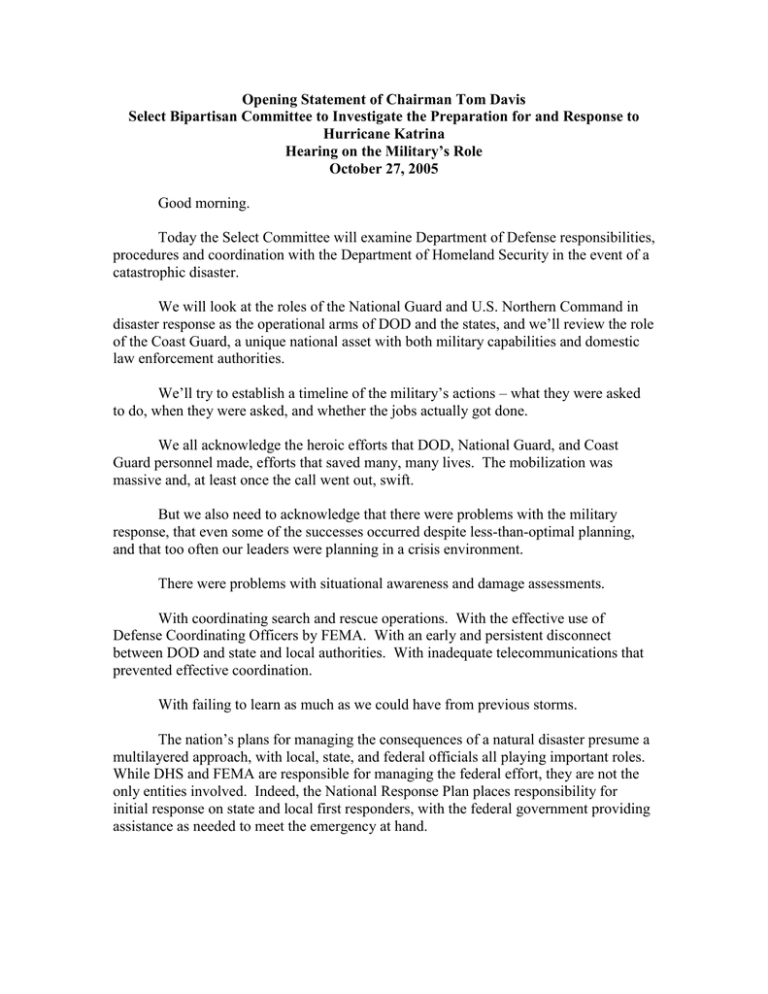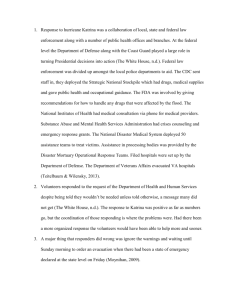Opening Statement of Chairman Tom Davis
advertisement

Opening Statement of Chairman Tom Davis Select Bipartisan Committee to Investigate the Preparation for and Response to Hurricane Katrina Hearing on the Military’s Role October 27, 2005 Good morning. Today the Select Committee will examine Department of Defense responsibilities, procedures and coordination with the Department of Homeland Security in the event of a catastrophic disaster. We will look at the roles of the National Guard and U.S. Northern Command in disaster response as the operational arms of DOD and the states, and we’ll review the role of the Coast Guard, a unique national asset with both military capabilities and domestic law enforcement authorities. We’ll try to establish a timeline of the military’s actions – what they were asked to do, when they were asked, and whether the jobs actually got done. We all acknowledge the heroic efforts that DOD, National Guard, and Coast Guard personnel made, efforts that saved many, many lives. The mobilization was massive and, at least once the call went out, swift. But we also need to acknowledge that there were problems with the military response, that even some of the successes occurred despite less-than-optimal planning, and that too often our leaders were planning in a crisis environment. There were problems with situational awareness and damage assessments. With coordinating search and rescue operations. With the effective use of Defense Coordinating Officers by FEMA. With an early and persistent disconnect between DOD and state and local authorities. With inadequate telecommunications that prevented effective coordination. With failing to learn as much as we could have from previous storms. The nation’s plans for managing the consequences of a natural disaster presume a multilayered approach, with local, state, and federal officials all playing important roles. While DHS and FEMA are responsible for managing the federal effort, they are not the only entities involved. Indeed, the National Response Plan places responsibility for initial response on state and local first responders, with the federal government providing assistance as needed to meet the emergency at hand. While local first responders may be best suited for handling local emergencies, the question remains what happens when first responders are overwhelmed, as they appear to have been in Hurricane Katrina. Today we’ll ask whether DOD anticipated these circumstances, what preparations were made, and what actions were taken with regard to the National Response Plan’s “Catastrophic Incident Annex” -- the annex that authorizes federal agencies to act when state and local capacity even to know what they need is compromised by the sheer size of the calamity. Today’s hearing on DOD’s role in Katrina comes amid growing debate over an expanded military role in future disasters. President Bush prompted the discussion in a nationally televised address from New Orleans on September 15, saying, “It is now clear that a challenge on this scale requires greater federal authority and a broader role for the armed forces -- the institution of our government most capable of massive logistical operations on a moment's notice.” Two of our witnesses today -- Secretary McHale and Admiral Keating – have indicated more recently that DOD is considering training and equipping an active duty force specifically for disaster response. These remarks have led to some confusion over specifics, and even to some outright opposition. On October 13, the National Governors Association issued a statement reasserting their authority. “Governors are responsible for the safety and welfare of their citizens and are in the best position to coordinate all resources to prepare for, respond to, and recover from disasters,” the association wrote. An October 21 statement by Fran Townsend, who is leading President Bush’s examination of the federal response to Katrina, has also spawned negative reactions from state officials. Townsend reportedly said she is considering whether there is, quote, “a narrow band of cases” in which the President should seize control when a disaster strikes. A spokesperson for Louisiana Gov. Blanco responded by saying she could not think of an instance in which the president should be able to unilaterally take control. “We don’t believe Katrina was the time, and I don’t know what another time would be,” Denise Bottcher told the Times-Picayune. There’s a basic tension here we need to explore. On the one hand, we hear understandable caution against over-reacting to Katrina with sweeping changes to laws or processes, caution against deviating too wildly from the locals-as-first-responders paradigm. I, for one, don’t want people thinking that the best lesson to be learned from Katrina is that all answers can be found in Washington. On the other, the call for increasing the military’s role in domestic affairs is easy to grasp. Who else can respond the way the military can? Who else can stand up when others have fallen? This tension was reflected in the National Response Plan before Katrina. On the one hand, the Catastrophic Incident Annex assumes that local response capabilities may be, quote, “insufficient,” as they will be, quote, “quickly overwhelmed.” On the other, the Plan states that Federal resources will only be integrated into the response effort upon a request by state and local authorities – and the Plan assumes that state and local officials will be able to do the integrating themselves. It seems our plan tries to have it both ways. Our plan may have too many cooks in the kitchen. So we need a closer evaluation of the existing procedures for DOD under the National Response Plan, paying particular attention to DOD’s role when first responders are wiped out or otherwise incapable of providing the initial response. I think most of us would agree that Incidents of National Significance require a Response on a National Scale. But the devil is in the details. We cannot expect the Marines to swoop in with MREs every time a storm hits. We train soldiers to fight wars; you can’t kill a storm. So what’s the threshold? What would spur the kind of enhanced or heightened military role that some have been promoting in the aftermath of Katrina? When would we pull that trigger? Would it have made a difference in the response to Katrina? The fact is, military resources are not infinite. It seems that the kind of standing humanitarian force that would be needed to provide this sort of immediate assistance at a moment’s notice would either threaten readiness or require an expansion of the active force and a significant boost in how well they’re equipped. There are legal questions that arise. Are we talking about statutory changes? Would we revisit Posse Comitatus? I think the most important issue to address is far simpler: Do we need a larger DOD role – or just a smarter one? As they say across the river, “When all you have is a hammer, everything looks like a nail.” As we review the good and the bad of the military’s performance in Katrina, and as we debate how to better prepare for the future, let’s make sure we’re not just hammering away at rusty nails. Focusing on trying to improve what was largely a passive response is like putting a new paint job on a Yugo. Prettier maybe, but still not reliable. Too much of what we’ve heard so far from FEMA and DHS and others fails to recognize that fundamental changes in disaster management may be needed. We have to stop waiting for the disaster that fits our response plan and instead design a scalable capacity to meet whatever Mother Nature throws at us. With Katrina, there was no shortage of plans. There was, however, a profound shortage of proactive execution. If 9/11 was a failure of imagination, then Katrina was a failure of initiative. We are not here to point fingers. We’re here to let experience be our teacher. Let’s remember today what an incredible job the Coast Guard did. Let’s acknowledge the National Guard’s clear sense of urgency. Let’s note for the record that Northern Command had prepared for this storm, deploying Defense Coordinating Officers to the three states before landfall and placing units on alert. But let’s also recognize that it remains unclear how much real support was in place before the storm arrived. Let’s recognize that Secretary McHale himself has said DOD’s response was too slow. We need to ask how many DOD personnel were stationed at the Superdome and Convention Center. About their role in providing food and water. About their role in maintaining law and order amid chaos. With today’s hearing we return to the confounding, life-and-death gap between theory and practice that underlies our overall investigation. This committee was created to attempt to bridge that gap, to confront the vast divide between policy creation and policy implementation. To make sure we are better prepared for the future. I thank our esteemed panels of witnesses for joining us today so that we can continue the process of learning from our mistakes.







